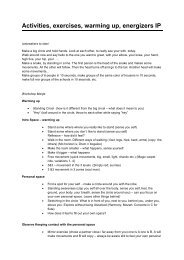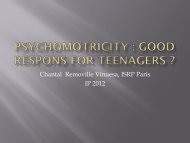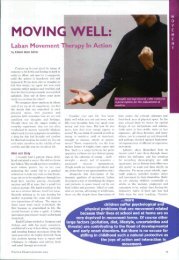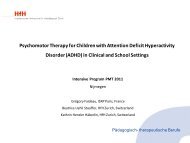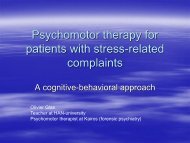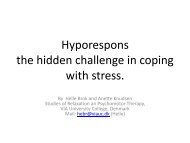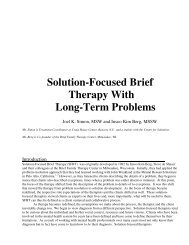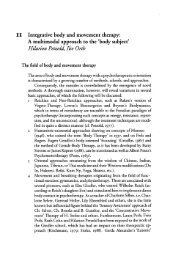Factors and Processes Contributing to Resilience
Factors and Processes Contributing to Resilience
Factors and Processes Contributing to Resilience
You also want an ePaper? Increase the reach of your titles
YUMPU automatically turns print PDFs into web optimized ePapers that Google loves.
194 Karol L. Kumpfer<br />
Temperament <strong>and</strong> Personality. Most resiliency researchers (Garmezy,<br />
1985; Rutter, Maughan, Mortimore, Ous<strong>to</strong>n, & Smith, 1979) regardless of<br />
their discipline, agree that constitutional <strong>and</strong> temperamental disposition is<br />
a major fac<strong>to</strong>r in resilience. Both Garmezy (1985) <strong>and</strong> Rutter (1979) have<br />
discussed positive temperament or positive personality disposition as one<br />
of the three major precursors of resilience; the other two fac<strong>to</strong>rs are supportive<br />
family milieu (family cohesion <strong>and</strong> warmth) <strong>and</strong> the availability <strong>and</strong><br />
use of external support systems by parent <strong>and</strong> child. In their 14-year study<br />
of ego resilience from pre-school <strong>to</strong> late adolescence, Block <strong>and</strong> Block<br />
(1980) found precursors of resilience in children <strong>to</strong> be positive temperament<br />
traits, such as responsiveness <strong>to</strong> environmental change, ability <strong>to</strong> be<br />
comforted after stress, <strong>and</strong> ability <strong>to</strong> maintain physiological equilibrium, as<br />
weil as <strong>to</strong> modify sleep-wakefulness states. Wertlieb <strong>and</strong> associates (1989)<br />
found three temperament traits related <strong>to</strong> effects of stress: distractibility,<br />
stimulus threshold sensitivity, <strong>and</strong> response <strong>to</strong> novel stimuli.<br />
A number of sturlies have supported the hypothesis that "difficult"<br />
temperament is associated with alcohol <strong>and</strong> other drug use in later life.<br />
A "difficult" temperament as defined by frequent negative moods <strong>and</strong><br />
withdrawal was found by Lerner <strong>and</strong> Vicary (1984) as correlated with later<br />
drug probJems in a longitudinal study that tracked kindergartners until<br />
adulthood. Children characterized as "easy" children. defined by greater<br />
adaptability <strong>and</strong> happier dispositions. were significantly less likely than<br />
"difficult" children <strong>to</strong> become adult regular users of <strong>to</strong>bacco, alcohol, <strong>and</strong><br />
ffi3T1JU8na.<br />
As described by Lerner<strong>and</strong> Vicary (1984), as well as Brook <strong>and</strong> associates<br />
(1990), two major temperament traits in children who Jater used<br />
drugs are: 1) negative mood states ( anxiety, irritability, sadness, emotional<br />
upset, anger <strong>and</strong> crying) <strong>and</strong> 2) social withdrawal. These are very similar<br />
<strong>to</strong> the two major temperament characteristics-aggression <strong>and</strong> shynessfound<br />
in the Kellam <strong>and</strong> Brown (1982) longitudinal study of adolescents<br />
who later used drugs. lf youth continue aggressive behaviors until13 years<br />
of age, they have a strong likelihood of developing alcoholism (Loeber,<br />
1988) or drug abuse (Barnes & Weite, 1986) <strong>and</strong> delinquency (S<strong>to</strong>uthamer<br />
Loeber et al., 1993). Hyperactivity, attention deficit disorder <strong>and</strong> oppositional<br />
defiant behavior in juniorhigh school aged children have been found<br />
<strong>to</strong> increase odds ratios for delinquency (S<strong>to</strong>uthamer-Loeber et al., 1993).<br />
Neurotransmitter lmbalances. Because of the consistent finding of<br />
temperament differences in negative life adjustment, temperament should<br />
be considered a significant risk fac<strong>to</strong>r leading <strong>to</strong> risk processes involving<br />
parents, teachers, <strong>and</strong> peers. Youth with difficulty, unpleasant, or aggressive<br />
temperaments are often rejected by other prosocial peers. The role of biological<br />
chemical imbalances (neurotransmitter or hormonal imbalances)



